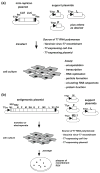Respiratory syncytial virus: virology, reverse genetics, and pathogenesis of disease
- PMID: 24362682
- PMCID: PMC4794264
- DOI: 10.1007/978-3-642-38919-1_1
Respiratory syncytial virus: virology, reverse genetics, and pathogenesis of disease
Abstract
Human respiratory syncytial virus (RSV) is an enveloped, nonsegmented negative-strand RNA virus of family Paramyxoviridae. RSV is the most complex member of the family in terms of the number of genes and proteins. It is also relatively divergent and distinct from the prototype members of the family. In the past 30 years, we have seen a tremendous increase in our understanding of the molecular biology of RSV based on a succession of advances involving molecular cloning, reverse genetics, and detailed studies of protein function and structure. Much remains to be learned. RSV disease is complex and variable, and the host and viral factors that determine tropism and disease are poorly understood. RSV is notable for a historic vaccine failure in the 1960s involving a formalin-inactivated vaccine that primed for enhanced disease in RSV naïve recipients. Live vaccine candidates have been shown to be free of this complication. However, development of subunit or other protein-based vaccines for pediatric use is hampered by the possibility of enhanced disease and the difficulty of reliably demonstrating its absence in preclinical studies.
Figures







References
-
- Asenjo A, Rodriguez L, Villanueva N. Determination of phosphorylated residues from human respiratory syncytial virus P protein that are dynamically dephosphorylated by cellular phosphatases: a possible role for serine 54. J Gen Virol. 2005;86(Pt 4):1109–1120. doi: 10.1099/vir.0.80692-086/4/1109. [pii] - DOI - PubMed
-
- Ausar SF, Espina M, Brock J, Thyagarayapuran N, Repetto R, Khandke L, Middaugh CR. High-throughput screening of stabilizers for respiratory syncytial virus: identification of stabilizers and their effects on the conformational thermostability of viral particles. Hum Vaccin. 2007;3(3):94–103. doi: 10.1099/vir.0.82165-04149. [pii] - DOI - PubMed
Publication types
MeSH terms
Substances
Grants and funding
LinkOut - more resources
Full Text Sources
Other Literature Sources
Medical
Miscellaneous

